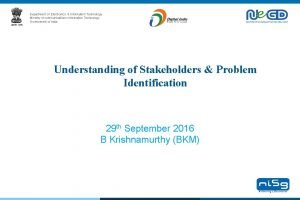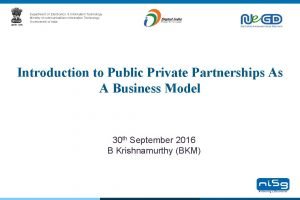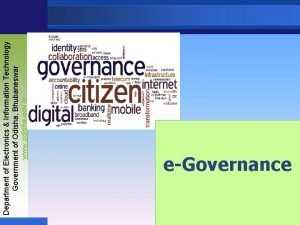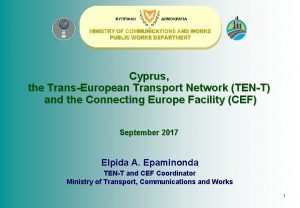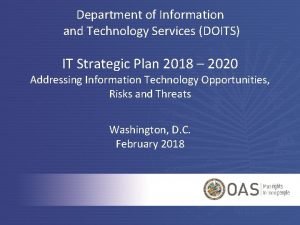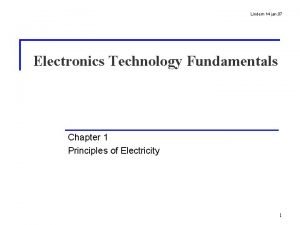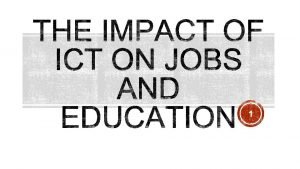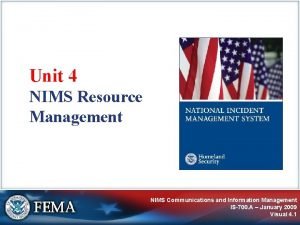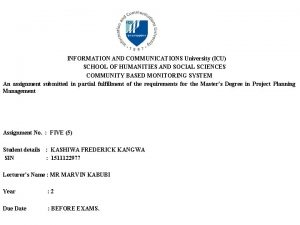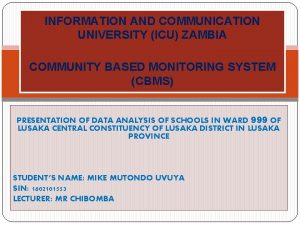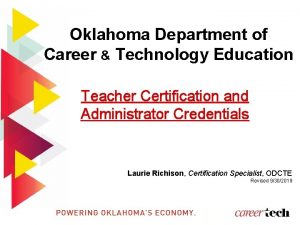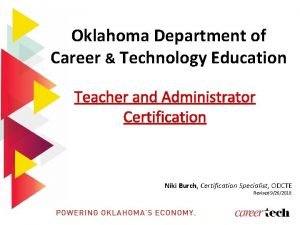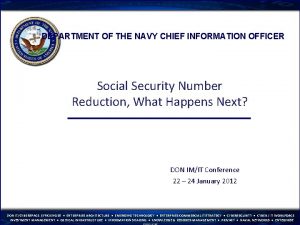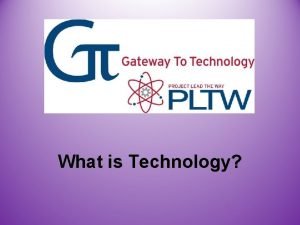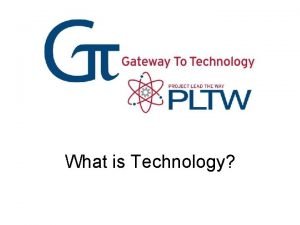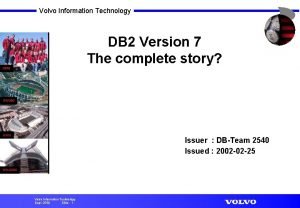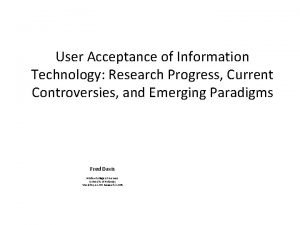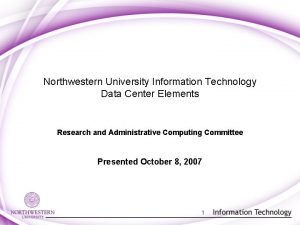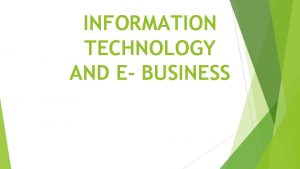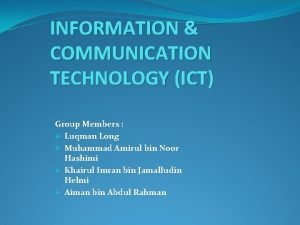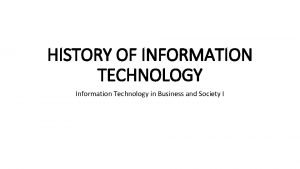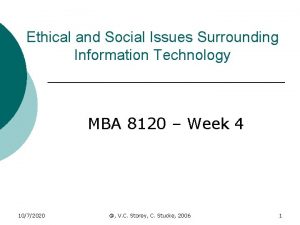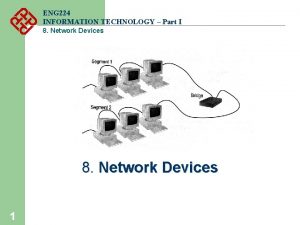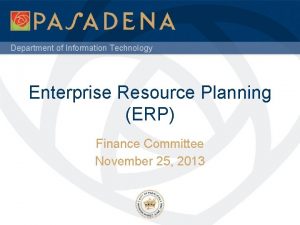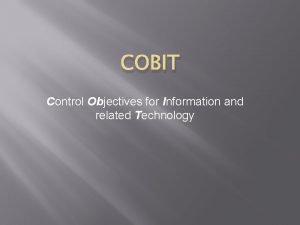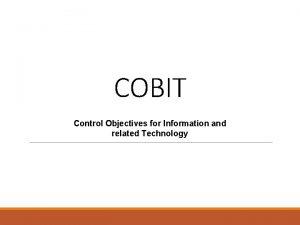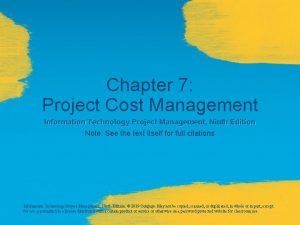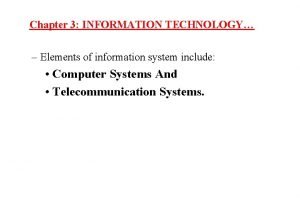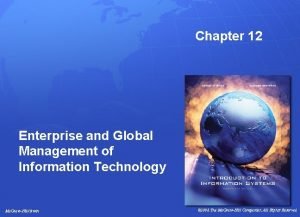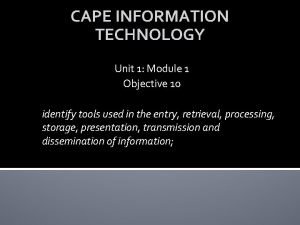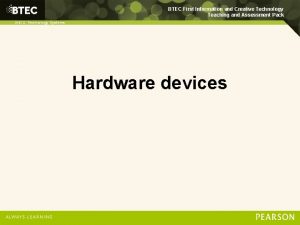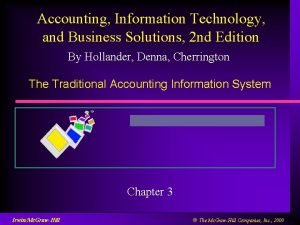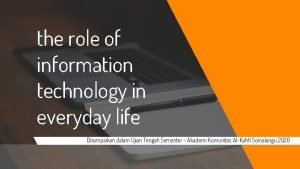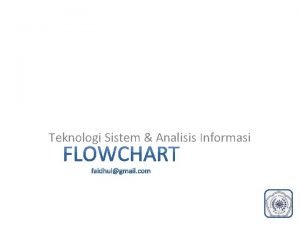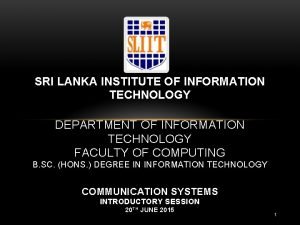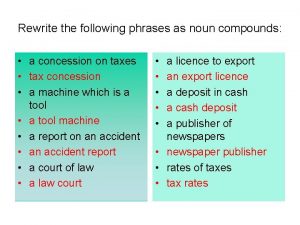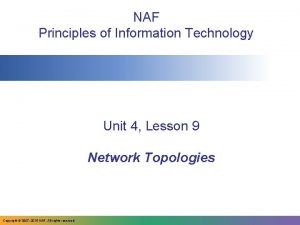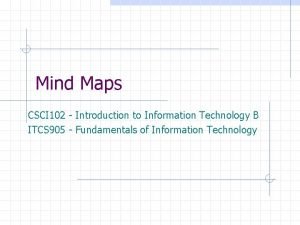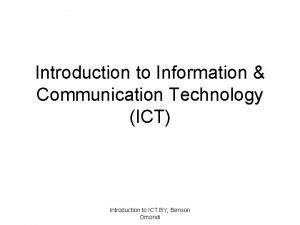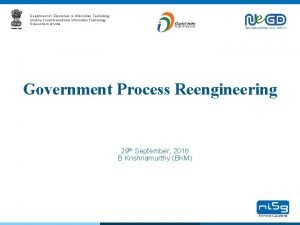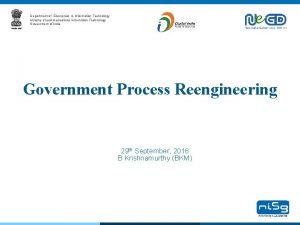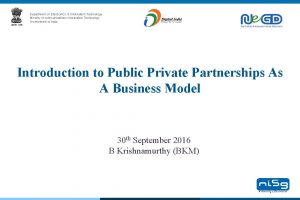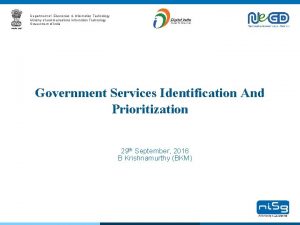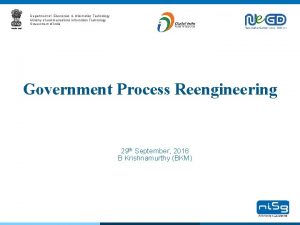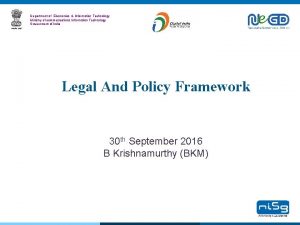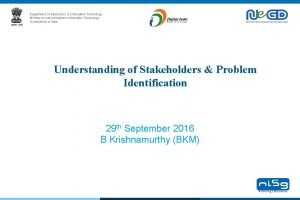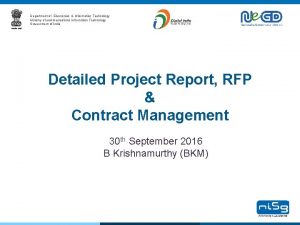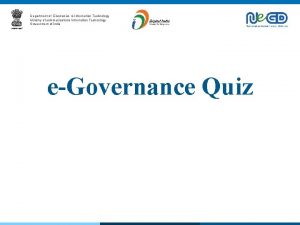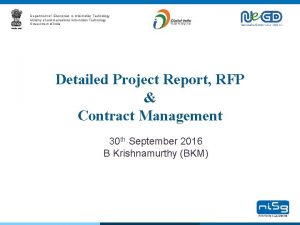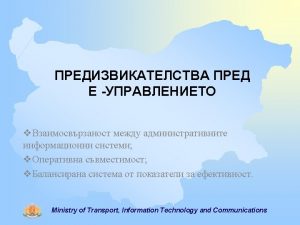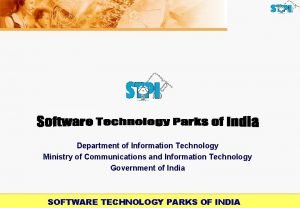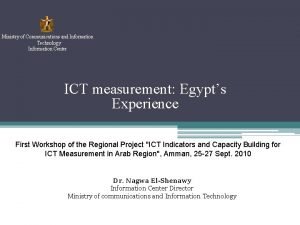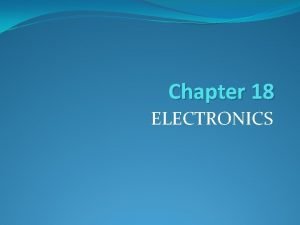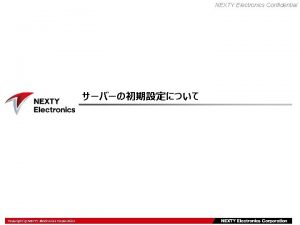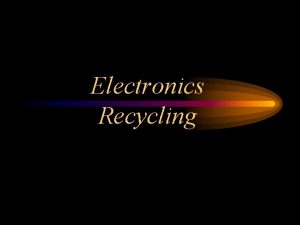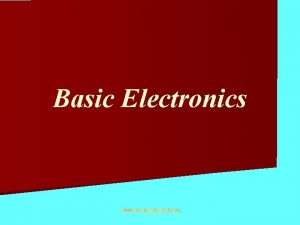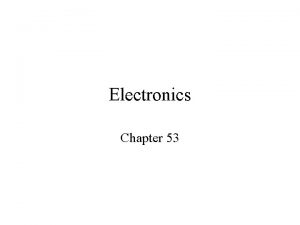Department of Electronics Information Technology Ministry of communications



















































- Slides: 51

Department of Electronics & Information Technology Ministry of communications Information Technology Government of India Detailed Project Report, RFP & Contract Management 30 th September 2016 B Krishnamurthy (BKM) Copyright 2015 -2017, Government of India (Diet. Y) All rights reserved 08 -09 -2015

Agenda v What is a Detailed Project Report v Various Sections of a DPR v Contract Management Copyright 2015 -2017, Government of India (Diet. Y) All rights reserved 2

e-Governance Project Lifecycle (e. GLC) 1. Vision & Strategy Development 2. Current State Assessment 3. Future State Definition 4. Implementation approach and sourcing 5. Develop and implement IT system 6. Operate and sustain Project Management Office/Unit Change Management and Communications Copyright 2015 -2017, Government of India (Diet. Y) All rights reserved 3

When Is A DPR Prepared? Vision & Strategy Development Stakeholder Needs Assessment Define clear vision & objectives Current State Assessment Critical assessment of current business processes and pain areas Best practices in Prioritization of similar environments services and projects Assess legal Incorporate domestic framework and global learnings current limitations Identify institutional structures & capacities for implementation Define funding requirements Define monitoring and evaluation approach. Assess current ICT systems and their ability to support future plans Future State Definition Process reengineering and to –be process definition Identity IT enablement opportunities and requirements Define changes to the legal and regulatory environment Implementation approach and sourcing Define implementation approach and phasing plan (functional and geographic) Assess detailed funding requirements and business model Prepare DPR Develop vendor evaluation and selection criteria Develop People change and capacity Develop KPIs and building plan Assessment of performance levels for current capacities at services and systems Develop project all levels and their Develop RFP preparedness for e- awareness and communication governance. Bid evaluation and requirements… vendor selection Copyright 2015 -2017, Government of India (Diet. Y) All rights reserved Develop and implement T system Operate and sustain Definition of detailed System operations and maintenance functional and technical requirements Software change management System design and development Rollout services and systems (functionality Software quality and geography) assurance, acceptance testing Objectives and auditing benefits evaluation Training and capacity and reinforcement building Sustained change, Change management capacity building and communications. . and project communications Project documentation Project go-live 4

When Is A DPR Prepared? Vision & Strategy Development Stakeholder Needs Assessment Define clear vision & objectives Current State Assessment Critical assessment of current business processes and pain areas Best practices in Prioritization of similar environments services and projects Assess legal Incorporate domestic framework and global learnings current limitations Identify institutional structures & capacities for implementation Define funding requirements Define monitoring and evaluation approach. Assess current ICT systems and their ability to support future plans Future State Definition Process reengineering and to –be process definition Identity IT enablement opportunities and requirements Define changes to the legal and regulatory environment Implementation approach and sourcing Define implementation approach and phasing plan (functional and geographic) Assess detailed funding requirements and business model Prepare DPR Develop vendor evaluation and selection criteria Develop People change and capacity Develop KPIs and Assessment of building plan performance levels for current capacities at services and systems Develop project all levels and their Develop RFP preparedness for e- awareness and communication governance. Bid evaluation and requirements… vendor selection Copyright 2015 -2017, Government of India (Diet. Y) All rights reserved Develop and implement T system Operate and sustain The highlighted activities Definition of detailed System operations and functional ande. GLCmaintenance in the provide technical requirements Software change inputs to the DPR System design and development management Rollout services and However, DPR(functionality may Software quality thesystems assurance, and geography) maketesting provisions of acceptance Objectives and auditing detailed study or benefits evaluation Training and capacity and reinforcement implementation in some building change, of. Change these areas. Sustained e. g. Legal management capacity building and communications. . and project reforms may be a communications separate project Project documentation Project go-live 5

What is a Detailed Project Report (DPR)? v Complete Document for Investment Decision Making & Approval v Base Document for Planning & Implementation of Project v It helps in management of scope, cost, procurement, schedule & risk v Helps Identify Interventions Required for People, Process, Technology & Implementation Copyright 2015 -2017, Government of India (Diet. Y) All rights reserved 6

4 Questions to be addressed for e. Gov Projects Q#1 WHAT do we want to Achieve ? Objectives, Service Levels, Outcomes, Impact Q#2 HOW do we want to Implement ? Technology, Process, Delivery Channels Q#3 WITH WHAT resources ? Business Model, Service Charges, PPP Q#4 WHO will be responsible ? Procurement, Training, Change Mgmt, O&M, M&E, Assessment Copyright 2015 -2017, Government of India (Diet. Y) All rights reserved 7

DPR - A High Level Document Project Vision And Objectives Project Scope : Functional scope & Geographical scope Benefits Envisaged : Quantifiable Stakeholders Involved : Roles and responsibilities Governance Mechanism : Decision making hierarchy Budgeted Cost Estimates : Time-wise and Head of Account wise Break-up Of Costs : Various items for which funds are required Implementation Plan : Pilot followed by roll out High Level Business Model : How will the project get paid for Sustenance : After the initial funding, sustenance of project Metrics For Measurement Of Project Outcomes And Impact Assessment (I. E. Envisaged Service Levels) Copyright 2015 -2017, Government of India (Diet. Y) All rights reserved 8

Why Detailed Project Report (DPR)? v It provides an overview of the envisaged project v Submitted for administrative sanction v Prepared very early in the project v Concept of the project explained v Project owner in Government is typically identified by the time DPR is prepared v Project Governance mechanism is also defined therein v Is prepared for § § Investment decision making Project Planning Approval of plans and designs Implementation scheduling and budgeting Copyright 2015 -2017, Government of India (Diet. Y) All rights reserved 9

The Pre-requisites For Preparing A DPR? v Defining vision for e-Governance project v Defining governance mechanism v Identification of problems / needs v Baseline study v Stakeholder analysis v Scoping study Copyright 2015 -2017, Government of India (Diet. Y) All rights reserved 10

v v v v 1. Defining Vision For e-Governance Project Tells about the intended end state What a project intends to achieve States what needs to be achieved by when Tall target and something that cannot be easily done Big thought Easy to understand Shared understanding of project objectives by various stakeholders Copyright 2015 -2017, Government of India (Diet. Y) All rights reserved 11

2. Defining Governance Mechanism v Multiple stakeholders are typically involved in project implementation v Mechanism required to sort out differences and agree on an approach acceptable to all the parties involved v Officers keep changing, a mechanism to ensure continuity of the project is required v Decision making hierarchy v Sanctioning authority Copyright 2015 -2017, Government of India (Diet. Y) All rights reserved 12

Generally Adopted Governance Mechanism Apex Committee / Steering Committee / Empowered Committee • A body empowered to take all strategic decisions pertaining to the project • Typically has Principal Secretary and Secretary level officers as members • Constituted by obtaining approval of a senior administration officer or by legislation or by legislative amendment • Convened frequently till vendor finalization and in early days of Go-live v Project Implementation Committee • Reviews details and provides tactical decisions • Has Director level officers and other senior government officers authorized to take decisions on day to day activities v Implementation Cell (PMU) • Monitors and manages vendor activities on a day to day basis • Housed under the agency designated to manage the project • Staff size is increased as the project grows • Resources herein are typically on contract and the team is managed by a Government officer v Copyright 2015 -2017, Government of India (Diet. Y) All rights reserved 13

3. Identification Of Problems / Needs How Can Problems Be Identified v Concerns raised by customers (citizens/businesses) v Concerns raised by internal stakeholders - employees v Through independent research/media Need For Pro-active Methods (Adoption of pro-active methods for problem identification is encouraged) v How does our service compare to other (state) governments? v What aspect of our service delivery customers do not feel satisfied; complex, painful and unnecessary? v What is the current world class benchmark level? Copyright 2015 -2017, Government of India (Diet. Y) All rights reserved 14

Problem Statement Needs to be Specific v v v The services are of very poor quality There is no transparency in government services I am not satisfied with the services We need to computerize this process/workflow (problems don’t define solutions) It is too expensive to deal with government Are the above statements examples of specific problem statements? None of these problem statements hint at the real ‘problems’ – they don’t identify the specific problems or specific needs with a specific service/specific task or specific output… Such problems are difficult to resolve…. Copyright 2015 -2017, Government of India (Diet. Y) All rights reserved 15

What Makes A Good Problem Statement? v States the effect and not the cause (What is wrong & not Why it is wrong) § It takes 30 -40 days to get Birth Certificate, do not get into why it takes such a long time v Focuses on the gap (between “What Is” & “What should be”) § Turn Around Time Metric is operating at 38% of the SLA. We should strive to get better v Is measurable (How often, How much, When) § Two months, ten visits, 38% v Is specific (avoids broad & ambiguous categories) v Is a statement, not a question § It requires minimum of ten visits to get the pension amount sanctioned v Focuses on the “Pain Area” (How Customers / Citizens, Employees and the Government are affected) § It should not take 2 months to get a death certificate Copyright 2015 -2017, Government of India (Diet. Y) All rights reserved 17

4. Baseline study v Survey done at start of the Project v Baseline data about parameters which is expected to show improvement is captured v Data on the same set of parameters will be collected after Go-live of project v Baseline data and post Go-live data will be compared to objectively evaluate whether the project has attained its laid down objectives Copyright 2015 -2017, Government of India (Diet. Y) All rights reserved 18

5. Stakeholder Analysis Copyright 2015 -2017, Government of India (Diet. Y) All rights reserved v Ensure Buy-in v Identify Champions v Improve Sensitivity Perceived Needs to 19

6. Scoping Study Copyright 2015 -2017, Government of India (Diet. Y) All rights reserved v Services & Service Levels v Organization Structure v Applications & Data v Technology 20

Main Sections of a DPR* Section III : Project details including its implementation model Section II : Project overview Section I : Background of project and other basic information *Based on DIT guidelines- Jan 09 Copyright 2015 -2017, Government of India (Diet. Y) All rights reserved

Section I: Background of project and other basic information Title of the Project Whether existing Mission Mode Project (MMP) Eligibility Tests- Ne. GP or Best Practice Alignment Whether Pilot or Roll out Project Initiator details Implementing Agency details Location of project implementation Copyright 2015 -2017, Government of India (Diet. Y) All rights reserved Section I : Background of project and other basic information

Section II: Project overview Section II : Project overview Identification of stakeholders From EGLC Phases: Problem to be addressed by project Causes and effects of the problem Category of services: G 2 C, G 2 B or G 2 G Proposed Services A. Vision & Strategy Development B. Current State Assessment C. To-be State Definition Past experience and lessons learnt Key activities and timelines From EGLC Phases: Project costs Source of funding Copyright 2015 -2017, Government of India (Diet. Y) All rights reserved A. Implementation Approach and Sourcing

Section III: Project details Section III : Project details including its implementatio n model Goal and Objectives • As a result of Vision & Strategy Development in EGLC • Objectives should be S. M. A. R. T (Specific, Measurable, Achievable, Realistic and Time Bound) Stakeholder Analysis • As a result of Vision & Strategy Development in EGLC • Discussed in previous section Services and Service levels • As a result of Vision & Strategy Development in EGLC • Service is the core services delivered by the Agency • Service levels are parameters for measuring efficiency, transparency & reliability of services • Service Levels defined in terms of- Quality, Quantity, Delivery time & Cost Copyright 2015 -2017, Government of India (Diet. Y) All rights reserved

Section III: Project details (contd. . ) Section III : Project details including its implementatio n model Implementation Strategy • As a result of Implementation approach and sourcing in EGLC • Horizontal or vertical functionality implementation • Prioritization criteria of implementation • Delivery channel strategy Scoping Study • Description and Recommendations for each sub-activity • Discussed in previous section Process Reengineering • As a result of Future State Definition in EGLC • Scope and purpose of intended process change • Mapping of existing processes • Identification of areas of inefficiency, duplication of efforts, redundancy etc • Preparation of blue print for improving efficiencies Copyright 2015 -2017, Government of India (Diet. Y) All rights reserved

Section III: Project details (contd. . ) Section III : Project details including its implementatio n model Change Management • As a result of Future State Definition in EGLC • Capacity Building, Awareness Creation, Legal Issues Infrastructure • As a result of Future State Definition and Current State Assessment in EGLC • Back-end, Middle ware: , Front-end , Network Architecture/ Devices, Information Security • As-Is, Option Analysis, To-Be Monitoring, Evaluation and Assessment • As a result of Vision & Strategy Development in EGLC • Impact/ Outcome Indicators, Output Indicators, Process Indicators • Means of verification Copyright 2015 -2017, Government of India (Diet. Y) All rights reserved

Section III: Project details (contd. . ) Section III : Project details including its implementatio n model Other Activities like civil works, etc Organization structure • As a result of Vision & Strategy Development in EGLC • Existing and Proposed Organization Structure • Staffing and deployment strategy Assumptions and Risk Management • Assumptions • Risk Assessment • Measures for risk mitigation Estimated demand growth rate of proposed services • In short, medium and long term Copyright 2015 -2017, Government of India (Diet. Y) All rights reserved

Section III: Project details (contd. . ) Section III : Project details including its implementation model Project Costs, Procurement and Financing • As a result of Vision & Strategy Development in EGLC • Project Cost • Investment Costs • Recurring Costs • Financing • Year-wise breakup of source • Amount of funds in form of assistance Public Private Partnership (PPP) • Financial Analysis • Business Model • Key Implementation Design Features Copyright 2015 -2017, Government of India (Diet. Y) All rights reserved

Section III: Project details (contd. . ) Section III : Project details including its implementation model Sustainability Plans • Procedural, staffing, budgetary and contractual arrangements to ensure sustainability of project outcomes Implementation arrangements • • As a result of Future State Definition in EGLC Management arrangements Contracting arrangements Accounting and audit arrangements Detailed Work Plan • • • As a result of Future State Definition in EGLC Phasing of project activities Schedule of implementation for each phase Identify critical dependencies in the project and Expected timelines for completion of key milestones Copyright 2015 -2017, Government of India (Diet. Y) All rights reserved

Service Level Management Copyright 2015 -2017, Government of India (Diet. Y) All rights reserved

Understanding Service Levels/KPIs in e-Governance ‘Services’ in an e-Government Project (differentiating government services and third party services) Government Services: Department Services identified for ‘e’ enablement. e. g. Services provided by third parties 1. Development of application software 1. Registration of companies 2. Implementation of IT infrastructure 2. Filing of returns 3. Issuing passports 3. Maintenance of systems and infrastructure 4. Registration of birth and death 4. Establishment of call centre 5. Payment of taxes and duties…… 5. Establishment of service delivery centers etc… Copyright 2015 -2017, Government of India (Diet. Y) All rights reserved

Understanding Service Levels/KPIs in e-Governance ‘Services’ in an e-Government Project (differentiating government services and third party services) Government Services: Department Services identified for ‘e’ enablement. e. g. Government is responsible for 1. Registration of companies ‘Quality’ of 2. Filing of returns Government Services 3. Issuing passports 4. Registration of birth and death 5. Payment of taxes and duties…… Copyright 2015 -2017, Government of India (Diet. Y) All rights reserved Services provided by third parties & Third party software 1. Development of application service provider is 2. Implementation of IT infrastructure responsible for ‘Quality’ of 3. Maintenance of systems and Systems/Technic infrastructure al services 4. Establishment of call centre 5. Establishment of service delivery centers etc…

Introduction to RFP Copyright 2015 -2017, Government of India (Diet. Y) All rights reserved

Procurement in e-Governance Projects – Life cycle • Set up Contract Governance • Monitoring and Evaluation • Exit Management • Periodic Review • Publish RFP • Selection of Vendor • Finalise Contract • Sign Contract Copyright 2015 -2017, Government of India (Diet. Y) All rights reserved Phase 4: Contract Manage ment Phase 3: Procure ment Phase 1: Business Case Phase 2: Decide Procure ment Strategy • Business Case for procurement • Understand cost components • Assess existing contracts / fresh procurement • Assess Procurement Options • Renegotiate existing contract/ Develop RFP / Bidding document • Develop Draft Contract

Regulatory Framework for Public Procurement • Public Procurement operates on the backbone of a broad framework of National laws dealing with relevant aspects of procurement. - Indian Contract Act, 1872; Sale of Goods Act, 1930; Companies Act, 1956; Arbitration & Conciliation Act, 1996; Limitation Act, 1963; Right to Information Act, 2005 • Public Procurement in India is a State subject, and thereby the Regulatory Framework governing Public Procurement varies from State to State • ‘General Financial Rules’ (GFR), framed by the central financial ministry acts as the guideline for public procurement, but has only subordinate legislation status • Various states have adopted their own Legal framework, like KTPP Act • Procurement funded by external donors (World Bank, ADB etc) follows guidelines by the donor in this regard Copyright 2015 -2017, Government of India (Diet. Y) All rights reserved

Planning the Procurement • Based on the Procurement context, any of the following procurement modes may be employed: - Two stage competitive process: Expression of Interest, followed by Request for Proposal open to bidders qualified from Eo. I process - Single stage competitive process: Request for Proposal open to all bidders fulfilling the qualifying criteria - Request for Quotes: Used for standardized requirements, in which price is the only deciding factor - Procurement from Rate Contracts: For items with standard specification, for which Rates have already been negotiated in the form of a Rate Contract by a nodal agency and economies of scale can be obtained - Single sourcing / Nomination: In cases where the required Solution / Product is available from only one vendor and there are no suitable alternatives (strong justification required) Copyright 2015 -2017, Government of India (Diet. Y) All rights reserved

Request for Proposal • A Request for Proposal (RFP) an invitation for suppliers, often through a bidding process, to submit a proposal on a specific commodity or service • The RFP process brings structure to the procurement decision and allows the risks and benefits to be identified clearly upfront • The RFP will have to specify in great detail, the following requirements of the Buyer: • Technical and Functional Requirements • Bid Process and Commercial Specifications • Contractual and Legal Specifications • The RFP is usually structured in 3 Volumes with one Volume for each one of the above requirements Copyright 2015 -2017, Government of India (Diet. Y) All rights reserved

Overview of selection through RFP Preparation and Publishing Preparation of RFP Preparation of Draft Contract Publishing of RFP Bidding Process Pre-bid Clarifications Corrigenda / Addenda Bid Preparation & Submission Bid Evaluation Process Prequalification Technical Evaluation Copyright 2015 -2017, Government of India (Diet. Y) All rights reserved & Commercial Evaluation Final Selection

RFP Volume I: Functional and Technical Specifications • Contents of Volume I are: • Introduction & Detailed Background of the Project • Project Vision, Mission and Objectives • Services Definition • Detailed Scope of Work for the Vendor • Functional Architecture & Requirements • Technical Architecture & Requirements (including Security Requirements) • Other Requirements (e. g. Data Migration, Digitization etc) • Timelines for implementation of the Project • Project Deliverables Copyright 2015 -2017, Government of India (Diet. Y) All rights reserved l. I lu a r t s e v ti

RFP Volume II: Bid Process & Commercial Specifications • Contents of Volume II are: • Bidding Terms and Conditions (Guidelines for preparing proposal) • Pre-qualification Criteria • Technical Evaluation Criteria • Bid Opening and Evaluation Process • Evaluation of Commercial Bids • Negotiations, Contract Finalization and Award • Formats for providing bid response • Pre-qualification • Technical and • Commercial Copyright 2015 -2017, Government of India (Diet. Y) All rights reserved l. I lu a r t s e v ti

• RFP Volume III: Contractual and Legal Specifications • Contents of Volume III are: • Roles and Responsibilities of Stakeholders • Service Level Agreement • Master Service Agreement • Scope of Services under the Contract • Breach, Rectification and Termination • Intellectual Property Rights • Disputes & Amendments • Change Control Schedule • Exit Management • Program Governance Structure & Schedule • Payment Terms and Schedule • Implementation Schedule Copyright 2015 -2017, Government of India (Diet. Y) All rights reserved Illu a r t s e v ti

Defining Of A Contract v A Contract may be defined as: “An agreement concerning promises made between two or more parties with the intention of creating certain legal rights and obligations upon the parties to that agreement which shall be enforceable in a court of law. ” v Contract Management is the final stage of Procurement cycle v The Contract includes all administrative activities associated with administering a contract after it is executed, including a review of the completed contract. v The level of contract may vary from simple to complex contract. The degree of effort put into contract management should commensurate with the value, risk and complexity of the contract Copyright 2015 -2017, Government of India (Diet. Y) All rights reserved 42

Reasons For Having A Contract v A Contract is necessary to ensure that the adequate safeguards are in place for the department and the vendor: § Safeguarding the interests of the contractual relationship § Ensuring compliance with the contract terms by the client and the vendor § Ensuring performance of all necessary actions of the project as laid down in the RFP § Managing and mitigating common risks § Monitoring performance of the vendor § Enforcing the Government’s rights when necessary (e. g. Intellectual Property Rights, Warranties etc) Copyright 2015 -2017, Government of India (Diet. Y) All rights reserved 44

What Is The Right Time For Contract Document Preparation? v In most e-Governance projects, the contract documents are prepared post award of contract to a vendor leading to: • Lack of clarity on specific terms and conditions of the contract during bidding processes – bids prepared based on assumptions • Dispute/disagreement on terms and conditions of the contract between selected vendor and government (as these terms are known to vendor/government post award of contract) • Significant time consumed in finalizing/agreeing on the terms – delaying the project and in some cases award of contract to a new vendor. The Contract Should Be Prepared Before Award Of The Contract Copyright 2015 -2017, Government of India (Diet. Y) All rights reserved 45

What Is The Right Time For Contract Document Preparation The contract document should be part of the RFP/Bidding documents issued for selection of vendor v Countries/agencies with matured procurement processes have Standard Bidding Documents and Draft Contracts as part of the bidding documents v Benefits: • Vendors and departments have better clarity on expected terms and conditions • Common understanding of contractual terms by all the participants • Necessary clarifications and corrections can be performed during bidding process - minimizing the time for contract signing • No scope for dispute/disagreement post award of contract v Copyright 2015 -2017, Government of India (Diet. Y) All rights reserved 46

Key Challenges In Current Contracts - 1 The issues that need your attention v Ambiguity surrounding the scope of work and responsibilities of stakeholders – flows from the RFP v Inadequate clarity on acceptance criteria for the deliverables v The conditions of the contract are largely one –sided (either government or vendor) v Ambiguity surrounding SLAs – lack of measurability v SLAs not inline with the business requirements v Lack of approach for addressing delays from Government – loss of time, investment and efforts of the vendor v Payment and profit risks to the vendors – significant delays in payment/tax variations can hit vendor profits significantly v Contracts are output based and not outcome based – however, vendors have little or no control on the project outcomes v Inadequate clarity on change control, ownership rights, IPR…. Copyright 2015 -2017, Government of India (Diet. Y) All rights reserved 47

Key Challenges In Current Contracts - 2 The issues that need your attention v Unlimited liability to the vendor v Incomplete scope of work – scope is proposed to be finalized post contract finalisation – how effort estimation can be done by the vendor? v Unlimited support for changes in the requirements v Ambiguity in data digitization requirements – requirements not spelt clearly v Source code requirement for COTS product!!! v 24 x 7 support? ? ? v No clarity on transaction volumes, users and data v Unreasonable payment schedules v Vendor evaluation and selection criteria – not inline to select the right vendor – largely based on least cost selection Copyright 2015 -2017, Government of India (Diet. Y) All rights reserved 48

Should There Be Standard Contract Templates? Need for defining standard contract templates v Countries/agencies with matured procurement processes have established standard bidding documents/standard contract documents based on the type of the project/work v Eliminates duplication of efforts/reinventing the wheel for each project by each department v Eliminates the scope for creating (intentionally or unintentionally) ambiguity v Bidders and governments know what to expect – eliminates efforts on discussions and negotiations on contract with each project by each department v Can be based on best practices approach addressing the common issues related to each category of project…. Copyright 2015 -2017, Government of India (Diet. Y) All rights reserved 49

Defining Standard Contract Templates v Identification of standard e-Governance project categories (s/w development/IT Infrastructure implementation, service delivery, O & M…) v Assessment of common needs, issues and risks in these categories. v Development of standard contract templates for these project categories v Validation of these standard contract templates with legal experts and industry representations v Finalise the contract conditions and approach for using draft contracts § What sections can be changed § What sections should not be altered v Make standard contract templates available for all the departments v Capacity building on using the contract templates v Enforce adoption of these contract templates Copyright 2015 -2017, Government of India (Diet. Y) All rights reserved 50

Key Contents Of Contracts For e. Governance Projects - 1 Most of the Project Specific Information can flow from the RFP Document and shall include: § Scope of services/work for the vendor § Deliverables § Project Locations § Project timelines/project schedule § Project Duration § Acceptance criteria for the deliverables § Payment schedule § Obligations/Responsibilities of the Department § Service Levels/Performance Indicators § Penalties/Incentivisation measures (if any) § Scope change management approach etc Copyright 2015 -2017, Government of India (Diet. Y) All rights reserved 51

Key Contents Of Contracts For e-Governance Projects General conditions/terms/contents of the contract • Definitions of Terms used in the Contract • Conditions precedent to contract signing • Applicable Law governing the Contract • Currency of the contract • • Conditions on Taxes and Duties applicable for the contract, change in tax and duties and impact to project cost • Approach for modifications or variations to the contract Language of the contract and administration • Force majeure • Authorised representatives of the department and vendor • Conditions for suspension termination of contract • Arbitration and courts for dispute resolution • Liabilities of parties • Dispute resolution approach • Exit management Copyright 2015 -2017, Government of India (Diet. Y) All rights reserved and/or 52

Thank you bkm. krishnamurthy@gmail. com bkmurthy@bkms. in Copyright 2015 -2017, Government of India (Diet. Y) All rights reserved 53
 Ministry of electronics and information technology
Ministry of electronics and information technology Department of electronics & information technology
Department of electronics & information technology Latest electronic and information technology in odisha
Latest electronic and information technology in odisha Ministry of transport, communications and works
Ministry of transport, communications and works Department of information technology
Department of information technology Electronics technology fundamentals
Electronics technology fundamentals Communications technology
Communications technology Nims communications and information management
Nims communications and information management List of lecturers at icu zambia
List of lecturers at icu zambia Information and communication university
Information and communication university Oklahoma alternative placement program
Oklahoma alternative placement program Principal certification oklahoma
Principal certification oklahoma Department of information engineering university of padova
Department of information engineering university of padova Department of information engineering university of padova
Department of information engineering university of padova Department of the navy chief information officer
Department of the navy chief information officer Positive impacts of materials technology
Positive impacts of materials technology Science and technology
Science and technology Volvo information technology
Volvo information technology User acceptance of information technology
User acceptance of information technology Conclusion for ict
Conclusion for ict Media literacy vs information literacy comparison
Media literacy vs information literacy comparison Northwestern university information technology
Northwestern university information technology 5 disadvantages of information technology
5 disadvantages of information technology Information technology introduction
Information technology introduction Positive impacts of information technology
Positive impacts of information technology History information technology
History information technology Fluency with information technology
Fluency with information technology Social issues in information technology
Social issues in information technology Bridge information technology
Bridge information technology Erp information technology
Erp information technology Current and future trends of media and information quiz
Current and future trends of media and information quiz Cobit control objectives
Cobit control objectives Control objectives for information and related technology
Control objectives for information and related technology Information technology project management 9th edition
Information technology project management 9th edition Definitive estimate range
Definitive estimate range Information technology project management 9th edition ppt
Information technology project management 9th edition ppt Information technology chapter 3
Information technology chapter 3 Information technology auditing
Information technology auditing Global management technologies
Global management technologies Information technology resource management
Information technology resource management Cape information technology unit 1 notes
Cape information technology unit 1 notes Btec first engineering teaching and assessment pack
Btec first engineering teaching and assessment pack Accounting information technology and business solutions
Accounting information technology and business solutions Information technology in everyday life
Information technology in everyday life Flowchart analisis sistem
Flowchart analisis sistem Sri lanka institute of information technology
Sri lanka institute of information technology Compound nouns and noun phrases
Compound nouns and noun phrases Information technology unit 4
Information technology unit 4 Information technology mind map
Information technology mind map Media and information literacy memes
Media and information literacy memes Introduction to information and communication technology
Introduction to information and communication technology Head of information technology
Head of information technology
